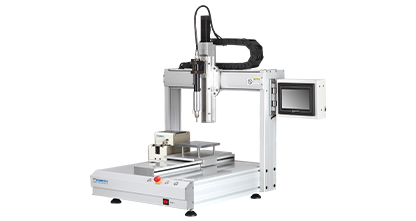The automatic screwdriver can effectively replace manual labor to complete the screw tightening work.Behind it is a set of orderly working principles,mainly covering the coordinated operation of multiple links such as screw feeding,positioning,and tightening.
In the screw feeding process,different types of feeding systems play their respective roles.The common vibrating disc feeding system generates vibration through the bottom vibrating motor,causing the screws placed on the spiral track to continuously move upward.The track is equipped with a special screening structure,which enables the screws to be neatly arranged in a specific direction and enter the conveying pipeline one by one.When the screw reaches the end of the pipe,it waits to be picked up.The adsorption feeding system relies on the principle of vacuum adsorption.At the end of the conveying pipeline,the adsorption head generates negative pressure through a vacuum pump to firmly adsorb the screws.Once the screws are attached,they will be transported to the selected position.The blow-type feeding system uses the power of compressed air to quickly blow the screws in the storage bin through pipes to the tightening mechanism.

After the screws are fed,they enter the positioning stage.Automatic screw machines are usually equipped with mechanical positioning structures or visual positioning systems.The mechanical positioning structure will design dedicated fixtures and guides based on the size and shape of the screws and products to ensure that the screws and products are assembled in fixed positions.The visual positioning system uses industrial cameras to capture the position and posture of screws and products.Through image recognition technology,it analyzes the relative position of screws and products,and then controls the mechanical arm or tightening mechanism to adjust to the accurate position.For instance,in the assembly of electronic components,the visual positioning system can quickly identify the exact positions of tiny screws and screw holes on the circuit board,ensuring that the screws are accurately aligned with the screw holes.
Next comes the tightening stage.When the screw is accurately sent to the tightening position,the tightening mechanism begins to work.The tightening mechanism is generally composed of a motor,a transmission device and a nozzle.The motor serves as the power source and transmits power to the nozzle through the transmission device.The screwdriver bit matches the screw head.When the motor rotates,the screwdriver bit drives the screw to rotate and gradually screw it into the corresponding screw hole of the product.During the tightening process,the rotational speed and torque of the motor can be set according to the specifications of the screw and the requirements of the product.For instance,for smaller screws,a smaller torque will be set to prevent the screws or products from being damaged.For larger and tighter screws,the torque will be increased to ensure that the screws are tightened properly.
In addition,the automatic screw machine is also equipped with a control system,which acts like the"brain"of the machine,coordinating the operation of each link.The operator can set parameters such as the screw feeding speed,tightening torque and positioning accuracy through the control system.The control system will,based on preset parameters,control the feeding system,positioning system and tightening mechanism to work in coordination.Once any abnormality occurs in any link,such as interruption of screw feeding or positioning deviation,the control system will promptly issue an alarm and stop the machine operation,allowing the operator to conduct inspection and handling.